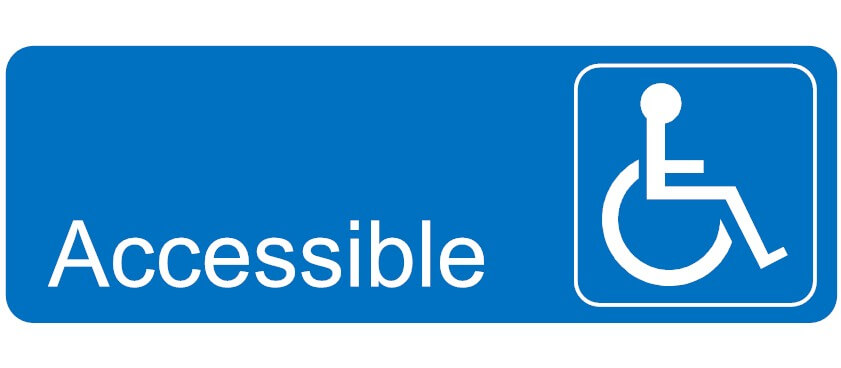Part 3, Employing Individuals with Disabilities, Person First Terminology, and Communication
Finding good employees can be a difficult task. You want to hire trustworthy and dependable workers who are great with customers and care about your business. Who’s to say that an individual with a disability wouldn’t be the right choice? It seems that in today’s society, inclusion in the workforce is more widely seen than ever before. This is likely due to the increased acceptance and respect of people with disabilities along with the requirements set forth in the Americans with Disabilities Act.
Americans with Disabilities Act (ADA)
As mentioned in part 1 and 2 of this series on accessibility, the Americans with Disabilities Act (ADA) is a civil rights law that protects all individuals with disabilities by prohibiting discrimination and ensuring equal opportunities in the community. Not only does this law apply in the community, but also to employment in state and local governments, employment agencies, labor unions, and private employers. It must include all employment practices including (but not limited to) hiring, firing, training, compensation, recruitment, and all other employment-related activities.
 Employing Individuals with Disabilities
Employing Individuals with Disabilities
Title I of the ADA focuses specifically on employing individuals with disabilities, and it’s a title that bar and restaurant owners are required to follow. It contains terms that every owner of a public company should know, including what constitutes a qualified individual with a disability, essential job functions, reasonable accommodation, and undue hardship. Being knowledgeable about the basics of these terms will be helpful in the long run and can in fact work in your favor if you hire or employ an individual with a disability.
A qualified individual with a disability is a person who meets all requirements of the job including education, experience, employment history, skills licenses, and the ability to perform the essential functions of the job.
Essential job functions are the fundamental duties of the job that the person must be able to perform with or without an accommodation. The term “essential” ensures that an individual with a disability will not be considered unqualified simply because of the inability to perform job functions that do not occur frequently. If the individual can perform the essential job functions with or without a reasonable accommodation, he/she must be considered.
A reasonable accommodation is any modification or adjustment to a job or work environment that will enable a qualified applicant or employee with a disability to perform essential job functions. Some examples include restructuring a job, modified work schedules, or using modified equipment. Reasonable accommodations must be provided unless an undue hardship to the employer will result.
An undue hardship refers to an action that would be so costly, disruptive, or extensive, that it would alter the operation of the business. Factors to consider are the nature and cost of the accommodation, the type of operation, the employer’s size and financial resources, and the impact of the accommodation on the operation.
In addition to these important terms, the ADA also states that:
- Employers may not retaliate against employees or applicants who apply the ADA.
- Employers may not ask an applicant whether or not he/she has a disability.
- Employers can deny employment to a person who poses a threat to the health and safety of himself/herself or others.
- Employers may not require a qualified potential employee to obtain a physical exam prior to the employment offer.
- Employees with disabilities must have available to them the same health insurance coverage as all other employees.
Person-First Terminology
Person-First terminology is communication which focuses on the person first. In the realm of disabilities, this type of communication would recognize the person first before the individual’s disability. So instead of saying the “autistic boy,” you would say the “boy with autism.” Or instead of staying the “deaf woman,” you would say the “woman who is deaf.” And in regular conversation, it’s not appropriate to even discuss a person’s disability unless it is relevant to the topic of conversation. The best way to not confuse this terminology is to refer to every individual by his or her name; plain and simple.
Communication
Whether you are speaking to an employee or a customer who has a disability, it’s important that you speak respectfully and appropriately in order to maintain a great relationship. Is this part of the ADA? No, but it is respectful, proper, and appropriate. Here are some considerations that you and your entire staff should follow when speaking to anyone with a disability:
- When talking to an individual with a disability, speak directly to that person rather than to the individual who may be accompanying him/her.
- When speaking to a person who uses a wheelchair, place yourself at eye level in front of the person to facilitate the conversation.
- Treat adults as adults. Address individuals by their first name and speak to them in a manner that is respectful and appropriate.
- Listen attentively when you are speaking with an individual who may have difficulty speaking. Be patient and wait for him/her to finish rather than speaking for him/her. Never pretend to understand what the individual is saying, rather repeat what you did understand and give him/her the opportunity to respond.
- When meeting a person with a visual impairment, always identify yourself and others who may be with you.
- Never lean or hang on a person’s wheelchair as it is often thought to be an extension of the individual’s personal space.
- Don’t assume that the only topic the individual with a disability wants to talk about is his or her disability. Rather, communication should focus on topics that are typical conversation amongst two individuals. And, when introducing someone with a disability, always refer to them by their first name. Do not mention their disability unless it is pertinent to the conversation at hand.
- Always use person-first terminology.
As we conclude this series on accessibility for bar and restaurant owners, we hope that we have opened your eyes to where your bar or restaurant stands with regard to accessibility and communication. Can your customers or employees with disabilities easily enter your establishment? Are they able to access services once they enter your doors? Do they feel accepted and respected when dealing with your staff? Those may be easy questions to answer but that’s just the tip of the iceberg. We encourage you to continue to formulate questions to answer that will help you evaluate your bar or restaurant when it comes to being accessible. These answers will allow you to make the necessary changes that will in turn welcome all customers into your establishment. And these changes will keep your doors wide open to the diversity that our world has to offer.







